Management and Organisations in a Global Environment: Report
VerifiedAdded on 2023/06/14
|8
|1383
|119
Report
AI Summary
This report discusses management and organisations in a global environment, focusing on e-learning activities related to corporate culture, HRM practices, customer satisfaction, and Toyota's corporate culture. It examines building a culture-based company, Toyota's organisational culture using the seven dimensions of organisational culture and the Cultural Web, and the relationship between strategy and structure. The report further explores Holacracy compared to bureaucracy and team-based structures, the impact of Contingency Factors of Organisational Design in the case of Zappos, and the relation between innovative culture and agile organisational structure. The conclusion emphasises the significance of corporate culture strategy and adaptation to change.
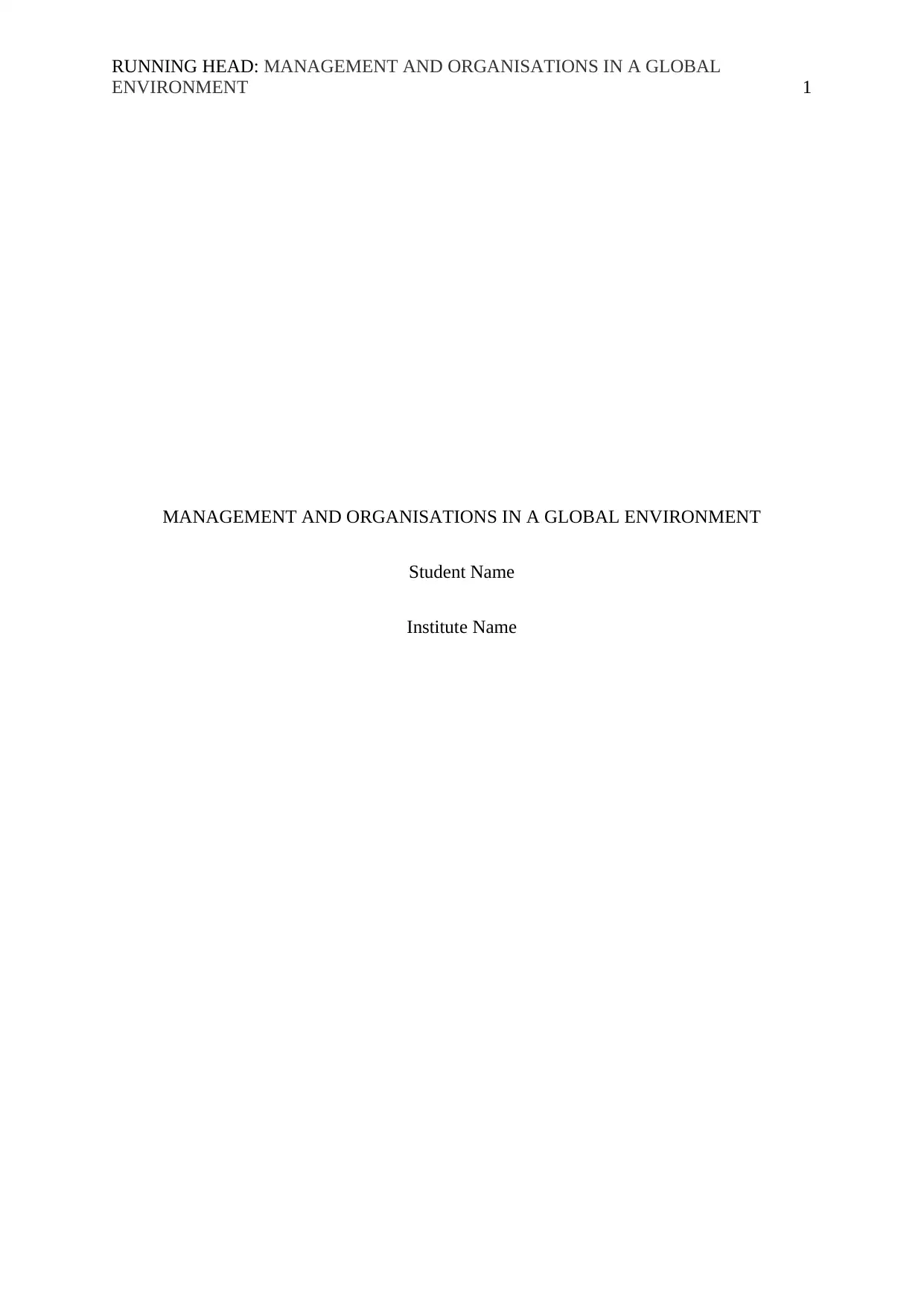
RUNNING HEAD: MANAGEMENT AND ORGANISATIONS IN A GLOBAL
ENVIRONMENT 1
MANAGEMENT AND ORGANISATIONS IN A GLOBAL ENVIRONMENT
Student Name
Institute Name
ENVIRONMENT 1
MANAGEMENT AND ORGANISATIONS IN A GLOBAL ENVIRONMENT
Student Name
Institute Name
Paraphrase This Document
Need a fresh take? Get an instant paraphrase of this document with our AI Paraphraser
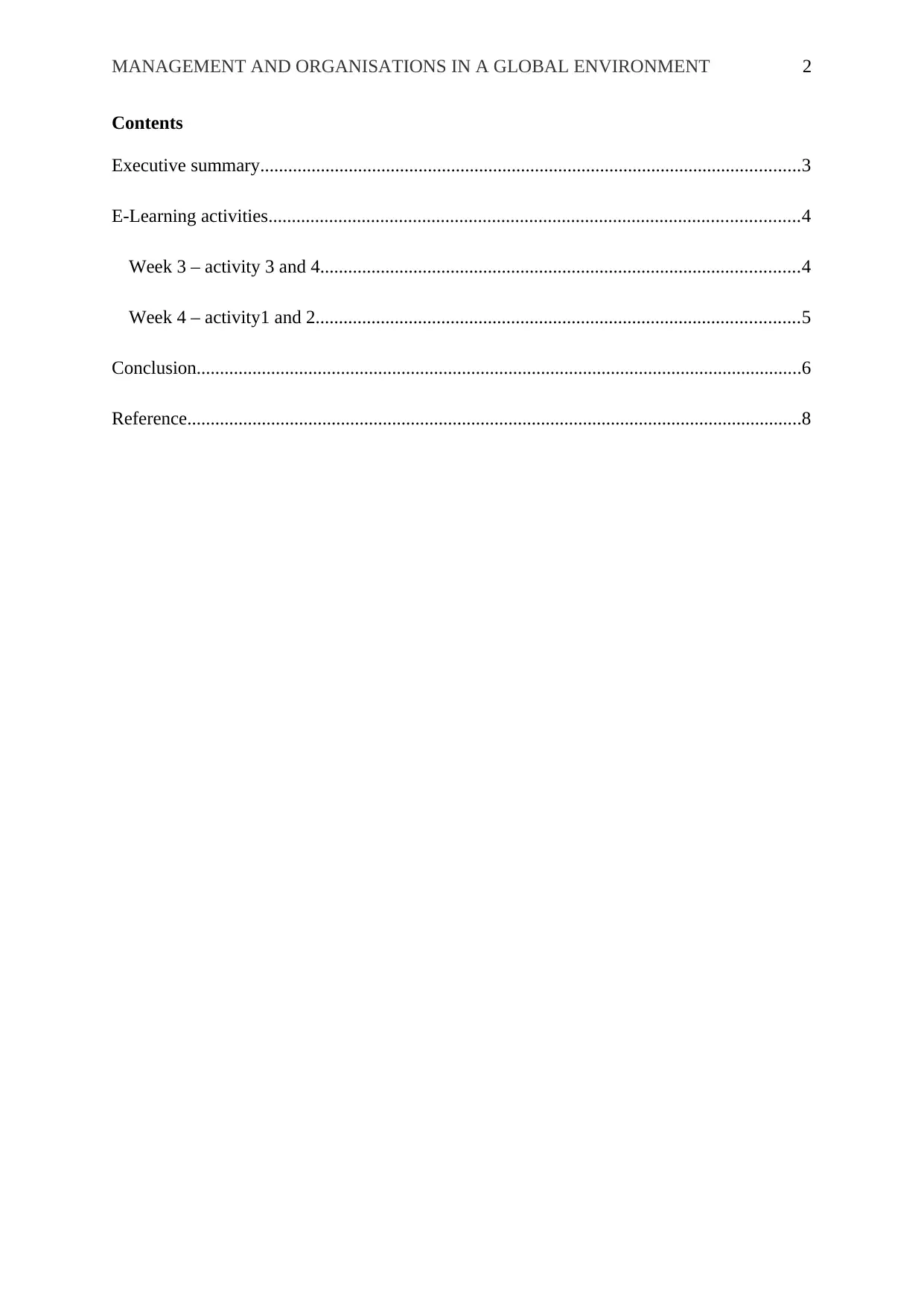
MANAGEMENT AND ORGANISATIONS IN A GLOBAL ENVIRONMENT 2
Contents
Executive summary....................................................................................................................3
E-Learning activities..................................................................................................................4
Week 3 – activity 3 and 4.......................................................................................................4
Week 4 – activity1 and 2........................................................................................................5
Conclusion..................................................................................................................................6
Reference....................................................................................................................................8
Contents
Executive summary....................................................................................................................3
E-Learning activities..................................................................................................................4
Week 3 – activity 3 and 4.......................................................................................................4
Week 4 – activity1 and 2........................................................................................................5
Conclusion..................................................................................................................................6
Reference....................................................................................................................................8
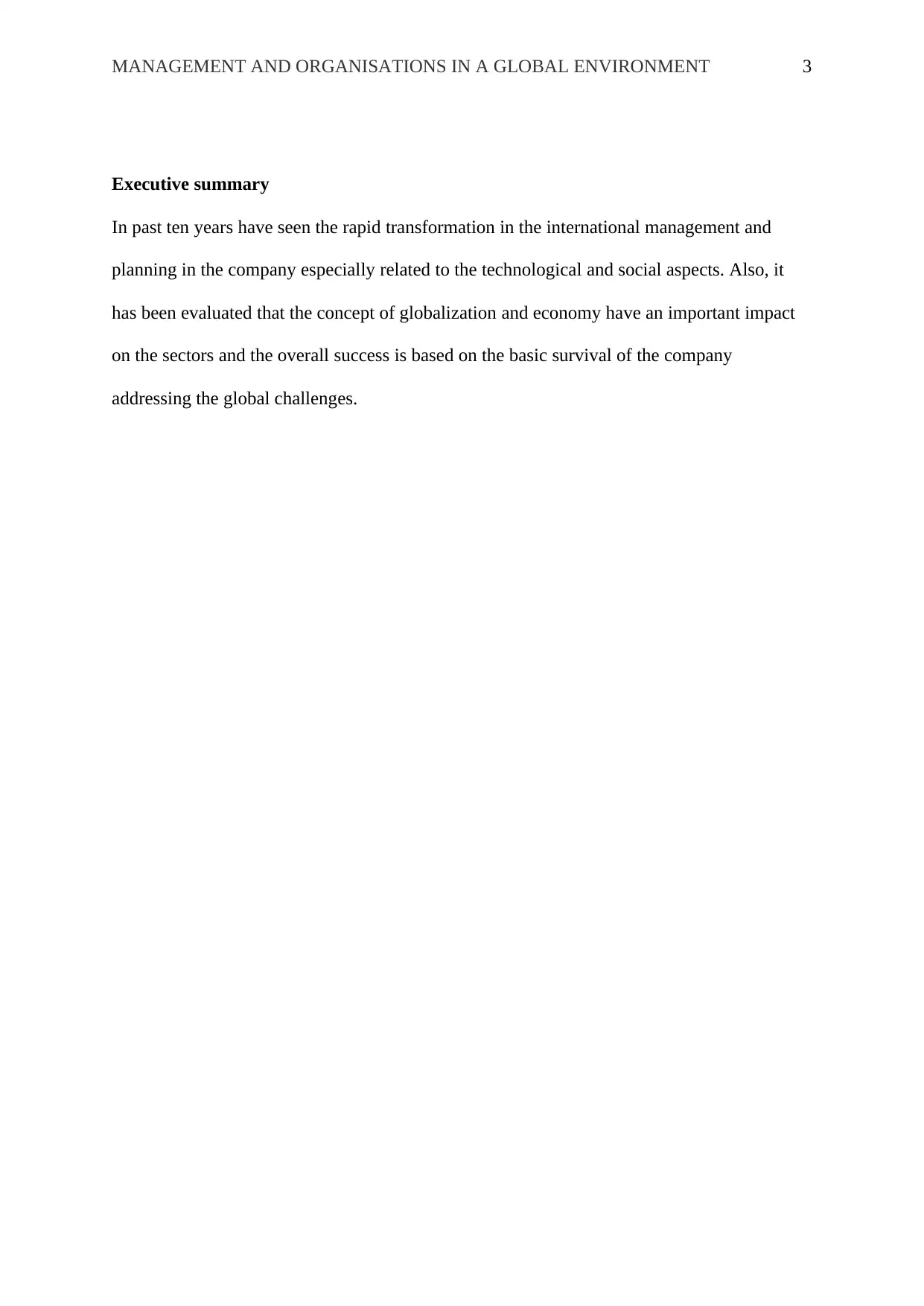
MANAGEMENT AND ORGANISATIONS IN A GLOBAL ENVIRONMENT 3
Executive summary
In past ten years have seen the rapid transformation in the international management and
planning in the company especially related to the technological and social aspects. Also, it
has been evaluated that the concept of globalization and economy have an important impact
on the sectors and the overall success is based on the basic survival of the company
addressing the global challenges.
Executive summary
In past ten years have seen the rapid transformation in the international management and
planning in the company especially related to the technological and social aspects. Also, it
has been evaluated that the concept of globalization and economy have an important impact
on the sectors and the overall success is based on the basic survival of the company
addressing the global challenges.
⊘ This is a preview!⊘
Do you want full access?
Subscribe today to unlock all pages.

Trusted by 1+ million students worldwide
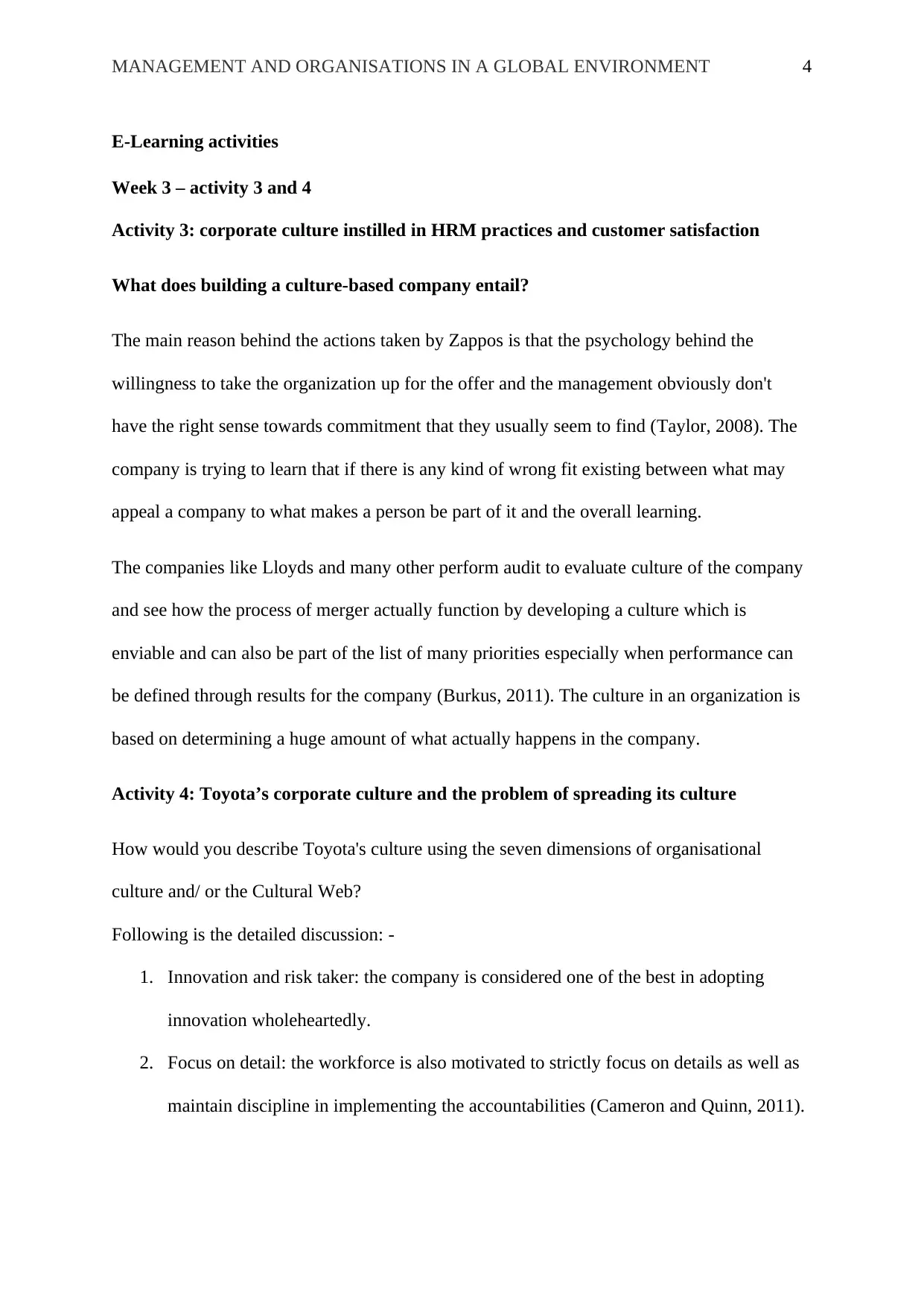
MANAGEMENT AND ORGANISATIONS IN A GLOBAL ENVIRONMENT 4
E-Learning activities
Week 3 – activity 3 and 4
Activity 3: corporate culture instilled in HRM practices and customer satisfaction
What does building a culture-based company entail?
The main reason behind the actions taken by Zappos is that the psychology behind the
willingness to take the organization up for the offer and the management obviously don't
have the right sense towards commitment that they usually seem to find (Taylor, 2008). The
company is trying to learn that if there is any kind of wrong fit existing between what may
appeal a company to what makes a person be part of it and the overall learning.
The companies like Lloyds and many other perform audit to evaluate culture of the company
and see how the process of merger actually function by developing a culture which is
enviable and can also be part of the list of many priorities especially when performance can
be defined through results for the company (Burkus, 2011). The culture in an organization is
based on determining a huge amount of what actually happens in the company.
Activity 4: Toyota’s corporate culture and the problem of spreading its culture
How would you describe Toyota's culture using the seven dimensions of organisational
culture and/ or the Cultural Web?
Following is the detailed discussion: -
1. Innovation and risk taker: the company is considered one of the best in adopting
innovation wholeheartedly.
2. Focus on detail: the workforce is also motivated to strictly focus on details as well as
maintain discipline in implementing the accountabilities (Cameron and Quinn, 2011).
E-Learning activities
Week 3 – activity 3 and 4
Activity 3: corporate culture instilled in HRM practices and customer satisfaction
What does building a culture-based company entail?
The main reason behind the actions taken by Zappos is that the psychology behind the
willingness to take the organization up for the offer and the management obviously don't
have the right sense towards commitment that they usually seem to find (Taylor, 2008). The
company is trying to learn that if there is any kind of wrong fit existing between what may
appeal a company to what makes a person be part of it and the overall learning.
The companies like Lloyds and many other perform audit to evaluate culture of the company
and see how the process of merger actually function by developing a culture which is
enviable and can also be part of the list of many priorities especially when performance can
be defined through results for the company (Burkus, 2011). The culture in an organization is
based on determining a huge amount of what actually happens in the company.
Activity 4: Toyota’s corporate culture and the problem of spreading its culture
How would you describe Toyota's culture using the seven dimensions of organisational
culture and/ or the Cultural Web?
Following is the detailed discussion: -
1. Innovation and risk taker: the company is considered one of the best in adopting
innovation wholeheartedly.
2. Focus on detail: the workforce is also motivated to strictly focus on details as well as
maintain discipline in implementing the accountabilities (Cameron and Quinn, 2011).
Paraphrase This Document
Need a fresh take? Get an instant paraphrase of this document with our AI Paraphraser
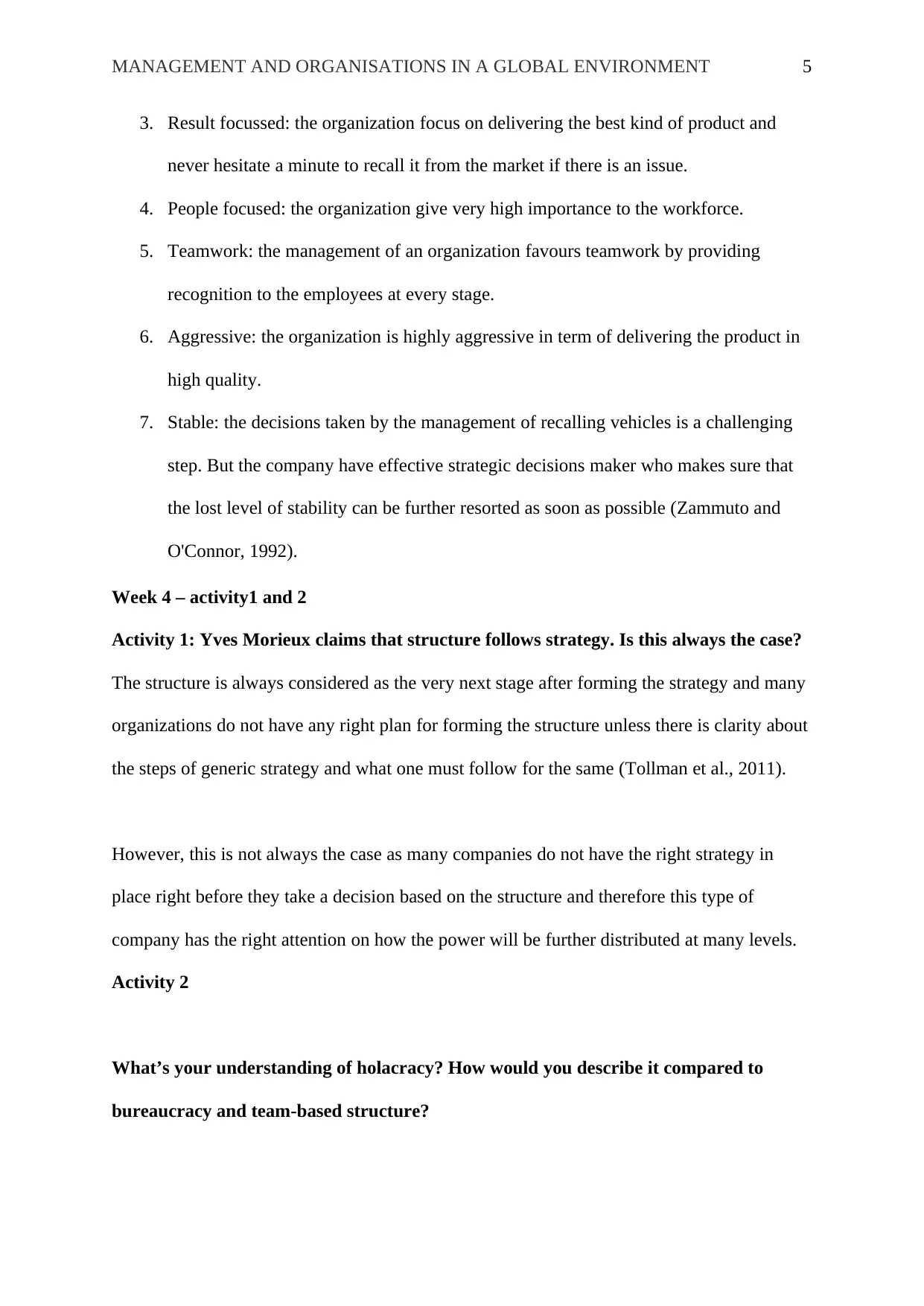
MANAGEMENT AND ORGANISATIONS IN A GLOBAL ENVIRONMENT 5
3. Result focussed: the organization focus on delivering the best kind of product and
never hesitate a minute to recall it from the market if there is an issue.
4. People focused: the organization give very high importance to the workforce.
5. Teamwork: the management of an organization favours teamwork by providing
recognition to the employees at every stage.
6. Aggressive: the organization is highly aggressive in term of delivering the product in
high quality.
7. Stable: the decisions taken by the management of recalling vehicles is a challenging
step. But the company have effective strategic decisions maker who makes sure that
the lost level of stability can be further resorted as soon as possible (Zammuto and
O'Connor, 1992).
Week 4 – activity1 and 2
Activity 1: Yves Morieux claims that structure follows strategy. Is this always the case?
The structure is always considered as the very next stage after forming the strategy and many
organizations do not have any right plan for forming the structure unless there is clarity about
the steps of generic strategy and what one must follow for the same (Tollman et al., 2011).
However, this is not always the case as many companies do not have the right strategy in
place right before they take a decision based on the structure and therefore this type of
company has the right attention on how the power will be further distributed at many levels.
Activity 2
What’s your understanding of holacracy? How would you describe it compared to
bureaucracy and team-based structure?
3. Result focussed: the organization focus on delivering the best kind of product and
never hesitate a minute to recall it from the market if there is an issue.
4. People focused: the organization give very high importance to the workforce.
5. Teamwork: the management of an organization favours teamwork by providing
recognition to the employees at every stage.
6. Aggressive: the organization is highly aggressive in term of delivering the product in
high quality.
7. Stable: the decisions taken by the management of recalling vehicles is a challenging
step. But the company have effective strategic decisions maker who makes sure that
the lost level of stability can be further resorted as soon as possible (Zammuto and
O'Connor, 1992).
Week 4 – activity1 and 2
Activity 1: Yves Morieux claims that structure follows strategy. Is this always the case?
The structure is always considered as the very next stage after forming the strategy and many
organizations do not have any right plan for forming the structure unless there is clarity about
the steps of generic strategy and what one must follow for the same (Tollman et al., 2011).
However, this is not always the case as many companies do not have the right strategy in
place right before they take a decision based on the structure and therefore this type of
company has the right attention on how the power will be further distributed at many levels.
Activity 2
What’s your understanding of holacracy? How would you describe it compared to
bureaucracy and team-based structure?
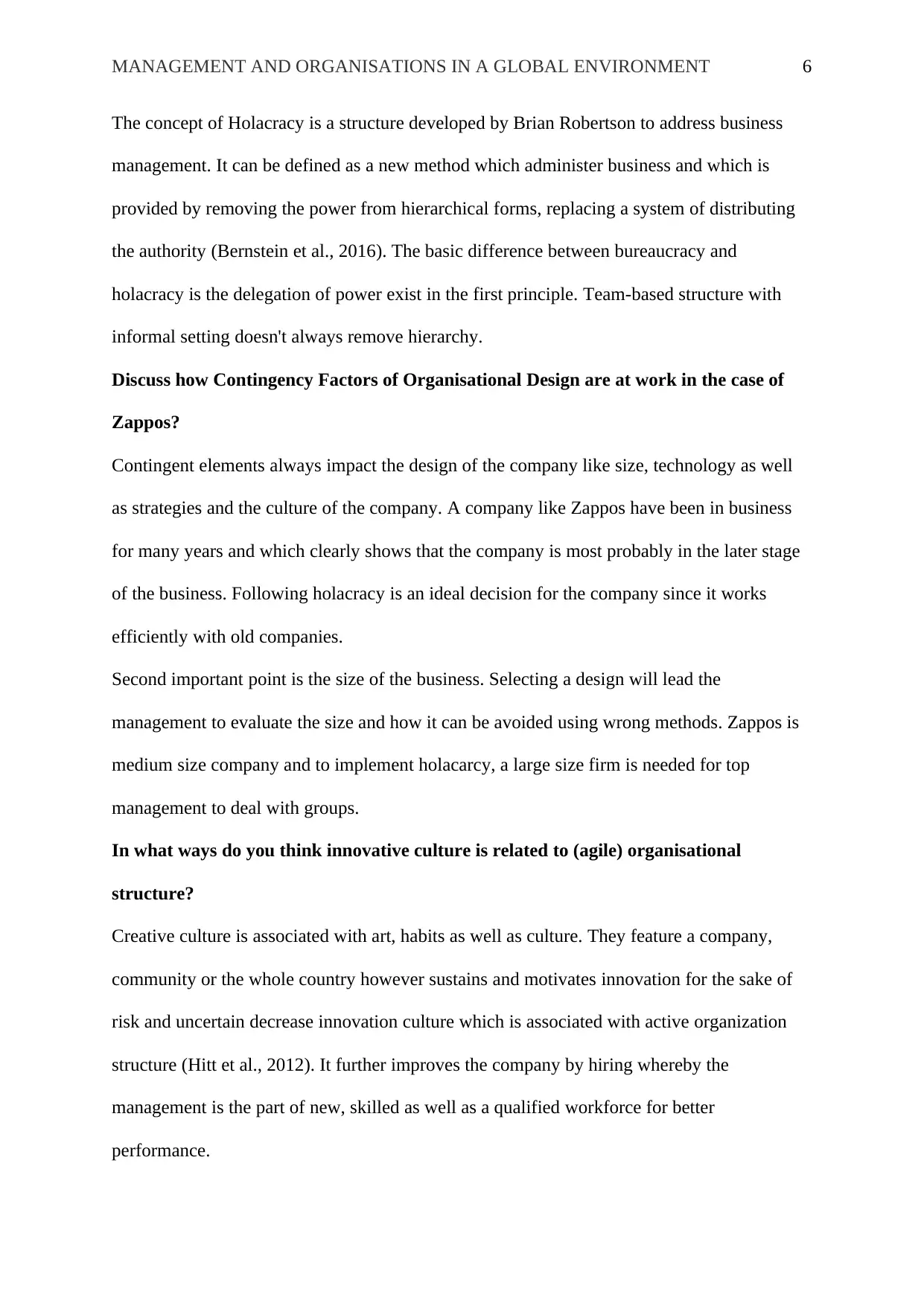
MANAGEMENT AND ORGANISATIONS IN A GLOBAL ENVIRONMENT 6
The concept of Holacracy is a structure developed by Brian Robertson to address business
management. It can be defined as a new method which administer business and which is
provided by removing the power from hierarchical forms, replacing a system of distributing
the authority (Bernstein et al., 2016). The basic difference between bureaucracy and
holacracy is the delegation of power exist in the first principle. Team-based structure with
informal setting doesn't always remove hierarchy.
Discuss how Contingency Factors of Organisational Design are at work in the case of
Zappos?
Contingent elements always impact the design of the company like size, technology as well
as strategies and the culture of the company. A company like Zappos have been in business
for many years and which clearly shows that the company is most probably in the later stage
of the business. Following holacracy is an ideal decision for the company since it works
efficiently with old companies.
Second important point is the size of the business. Selecting a design will lead the
management to evaluate the size and how it can be avoided using wrong methods. Zappos is
medium size company and to implement holacarcy, a large size firm is needed for top
management to deal with groups.
In what ways do you think innovative culture is related to (agile) organisational
structure?
Creative culture is associated with art, habits as well as culture. They feature a company,
community or the whole country however sustains and motivates innovation for the sake of
risk and uncertain decrease innovation culture which is associated with active organization
structure (Hitt et al., 2012). It further improves the company by hiring whereby the
management is the part of new, skilled as well as a qualified workforce for better
performance.
The concept of Holacracy is a structure developed by Brian Robertson to address business
management. It can be defined as a new method which administer business and which is
provided by removing the power from hierarchical forms, replacing a system of distributing
the authority (Bernstein et al., 2016). The basic difference between bureaucracy and
holacracy is the delegation of power exist in the first principle. Team-based structure with
informal setting doesn't always remove hierarchy.
Discuss how Contingency Factors of Organisational Design are at work in the case of
Zappos?
Contingent elements always impact the design of the company like size, technology as well
as strategies and the culture of the company. A company like Zappos have been in business
for many years and which clearly shows that the company is most probably in the later stage
of the business. Following holacracy is an ideal decision for the company since it works
efficiently with old companies.
Second important point is the size of the business. Selecting a design will lead the
management to evaluate the size and how it can be avoided using wrong methods. Zappos is
medium size company and to implement holacarcy, a large size firm is needed for top
management to deal with groups.
In what ways do you think innovative culture is related to (agile) organisational
structure?
Creative culture is associated with art, habits as well as culture. They feature a company,
community or the whole country however sustains and motivates innovation for the sake of
risk and uncertain decrease innovation culture which is associated with active organization
structure (Hitt et al., 2012). It further improves the company by hiring whereby the
management is the part of new, skilled as well as a qualified workforce for better
performance.
⊘ This is a preview!⊘
Do you want full access?
Subscribe today to unlock all pages.

Trusted by 1+ million students worldwide
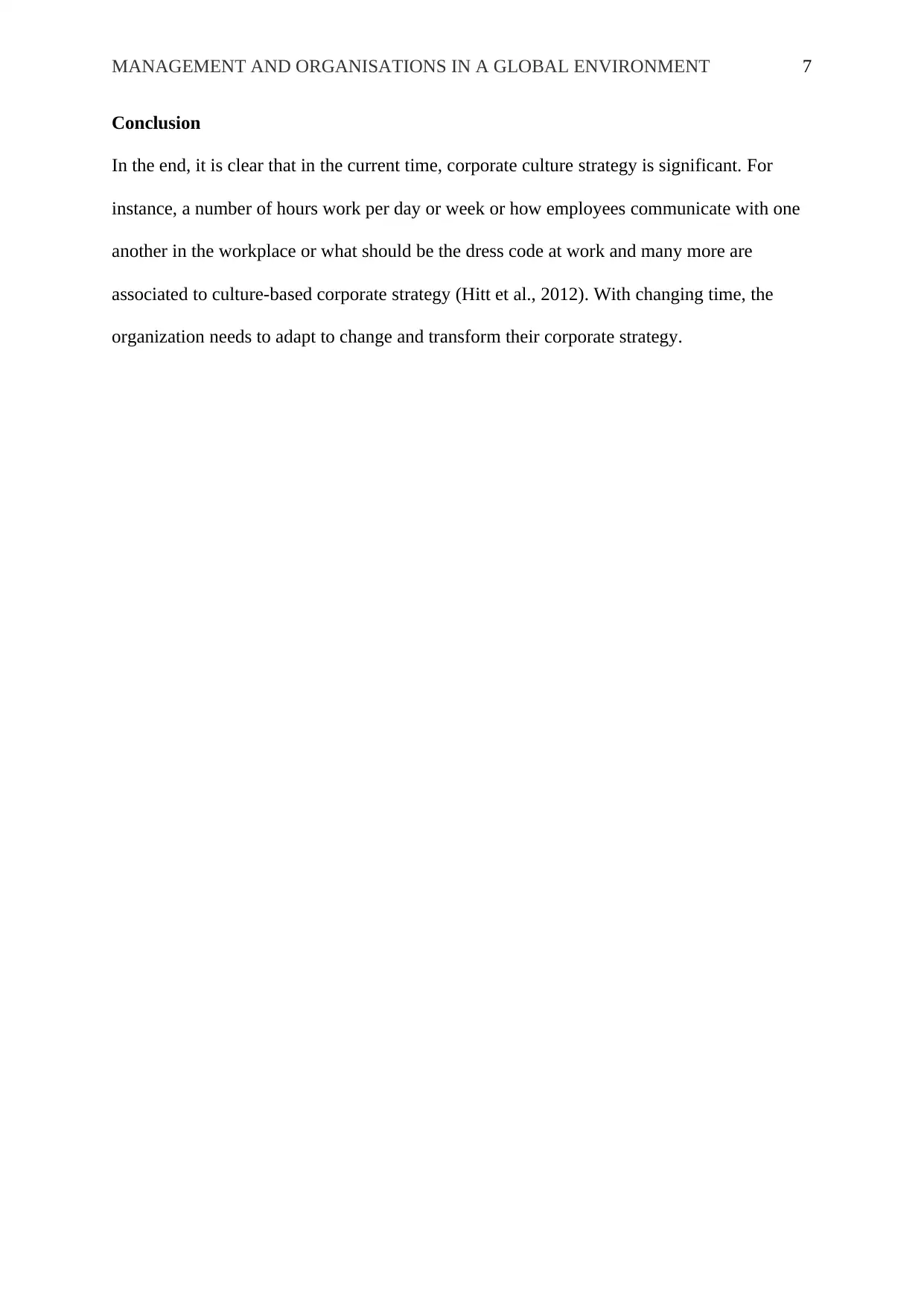
MANAGEMENT AND ORGANISATIONS IN A GLOBAL ENVIRONMENT 7
Conclusion
In the end, it is clear that in the current time, corporate culture strategy is significant. For
instance, a number of hours work per day or week or how employees communicate with one
another in the workplace or what should be the dress code at work and many more are
associated to culture-based corporate strategy (Hitt et al., 2012). With changing time, the
organization needs to adapt to change and transform their corporate strategy.
Conclusion
In the end, it is clear that in the current time, corporate culture strategy is significant. For
instance, a number of hours work per day or week or how employees communicate with one
another in the workplace or what should be the dress code at work and many more are
associated to culture-based corporate strategy (Hitt et al., 2012). With changing time, the
organization needs to adapt to change and transform their corporate strategy.
Paraphrase This Document
Need a fresh take? Get an instant paraphrase of this document with our AI Paraphraser
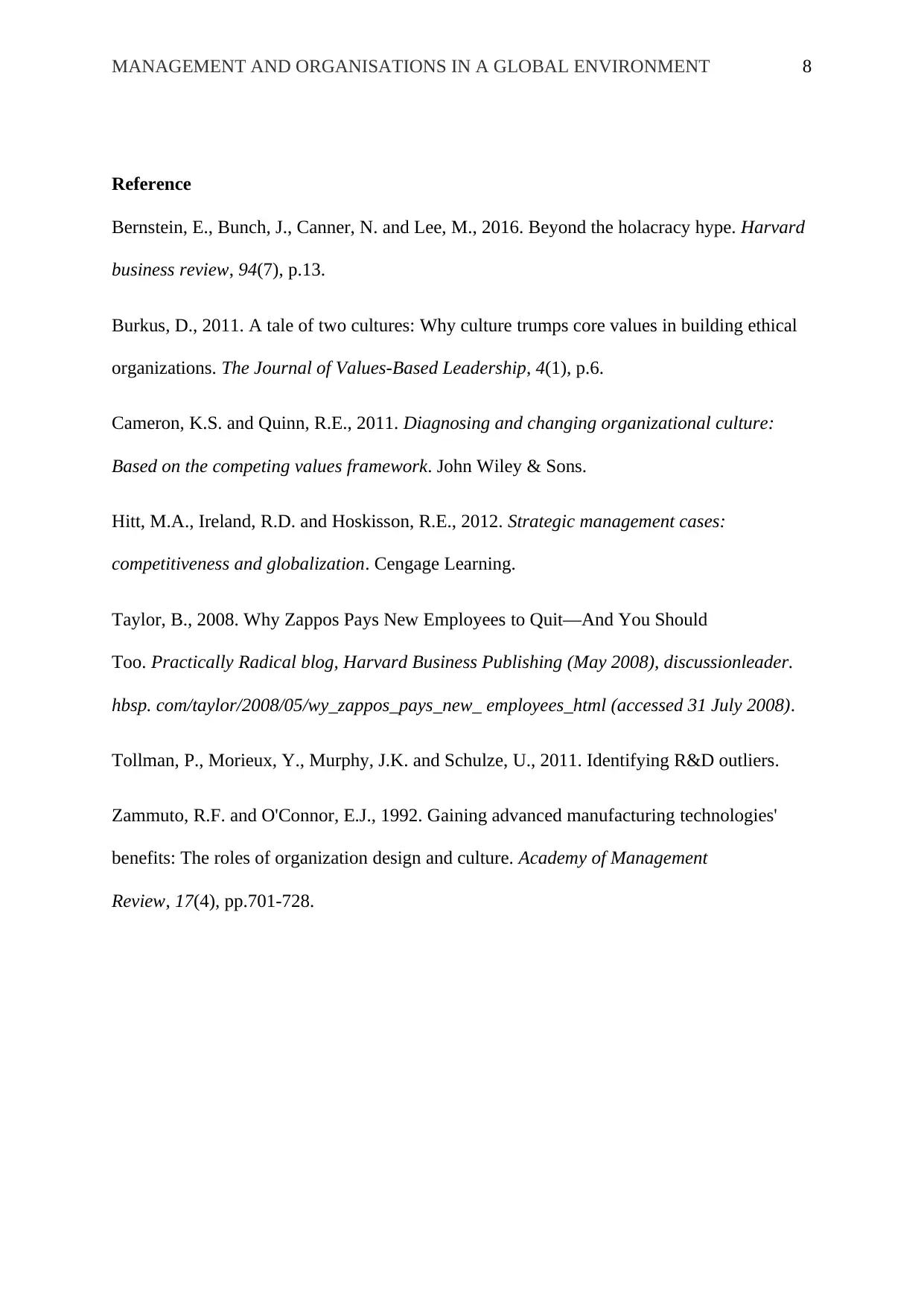
MANAGEMENT AND ORGANISATIONS IN A GLOBAL ENVIRONMENT 8
Reference
Bernstein, E., Bunch, J., Canner, N. and Lee, M., 2016. Beyond the holacracy hype. Harvard
business review, 94(7), p.13.
Burkus, D., 2011. A tale of two cultures: Why culture trumps core values in building ethical
organizations. The Journal of Values-Based Leadership, 4(1), p.6.
Cameron, K.S. and Quinn, R.E., 2011. Diagnosing and changing organizational culture:
Based on the competing values framework. John Wiley & Sons.
Hitt, M.A., Ireland, R.D. and Hoskisson, R.E., 2012. Strategic management cases:
competitiveness and globalization. Cengage Learning.
Taylor, B., 2008. Why Zappos Pays New Employees to Quit—And You Should
Too. Practically Radical blog, Harvard Business Publishing (May 2008), discussionleader.
hbsp. com/taylor/2008/05/wy_zappos_pays_new_ employees_html (accessed 31 July 2008).
Tollman, P., Morieux, Y., Murphy, J.K. and Schulze, U., 2011. Identifying R&D outliers.
Zammuto, R.F. and O'Connor, E.J., 1992. Gaining advanced manufacturing technologies'
benefits: The roles of organization design and culture. Academy of Management
Review, 17(4), pp.701-728.
Reference
Bernstein, E., Bunch, J., Canner, N. and Lee, M., 2016. Beyond the holacracy hype. Harvard
business review, 94(7), p.13.
Burkus, D., 2011. A tale of two cultures: Why culture trumps core values in building ethical
organizations. The Journal of Values-Based Leadership, 4(1), p.6.
Cameron, K.S. and Quinn, R.E., 2011. Diagnosing and changing organizational culture:
Based on the competing values framework. John Wiley & Sons.
Hitt, M.A., Ireland, R.D. and Hoskisson, R.E., 2012. Strategic management cases:
competitiveness and globalization. Cengage Learning.
Taylor, B., 2008. Why Zappos Pays New Employees to Quit—And You Should
Too. Practically Radical blog, Harvard Business Publishing (May 2008), discussionleader.
hbsp. com/taylor/2008/05/wy_zappos_pays_new_ employees_html (accessed 31 July 2008).
Tollman, P., Morieux, Y., Murphy, J.K. and Schulze, U., 2011. Identifying R&D outliers.
Zammuto, R.F. and O'Connor, E.J., 1992. Gaining advanced manufacturing technologies'
benefits: The roles of organization design and culture. Academy of Management
Review, 17(4), pp.701-728.
1 out of 8
Related Documents
Your All-in-One AI-Powered Toolkit for Academic Success.
+13062052269
info@desklib.com
Available 24*7 on WhatsApp / Email
![[object Object]](/_next/static/media/star-bottom.7253800d.svg)
Unlock your academic potential
Copyright © 2020–2025 A2Z Services. All Rights Reserved. Developed and managed by ZUCOL.


